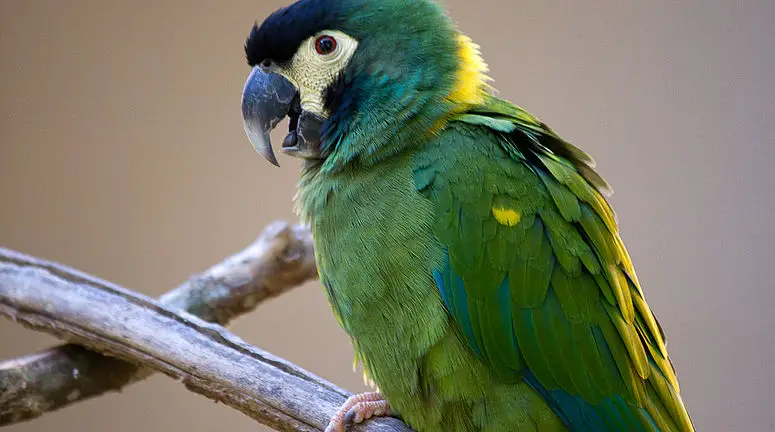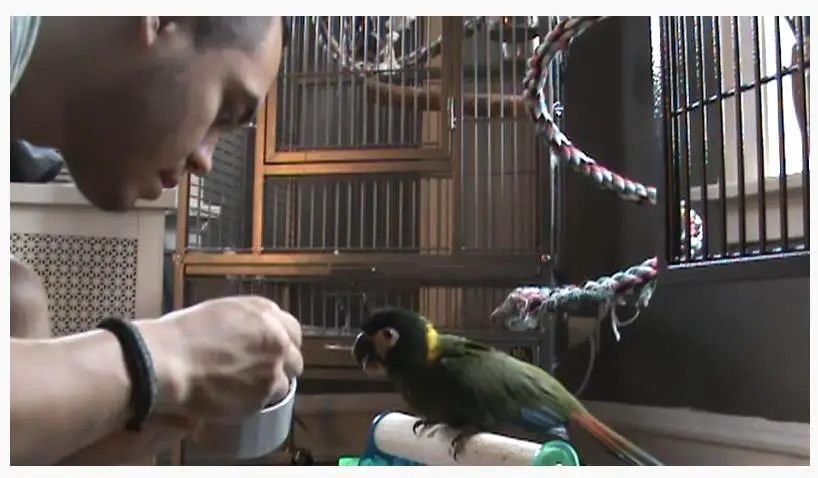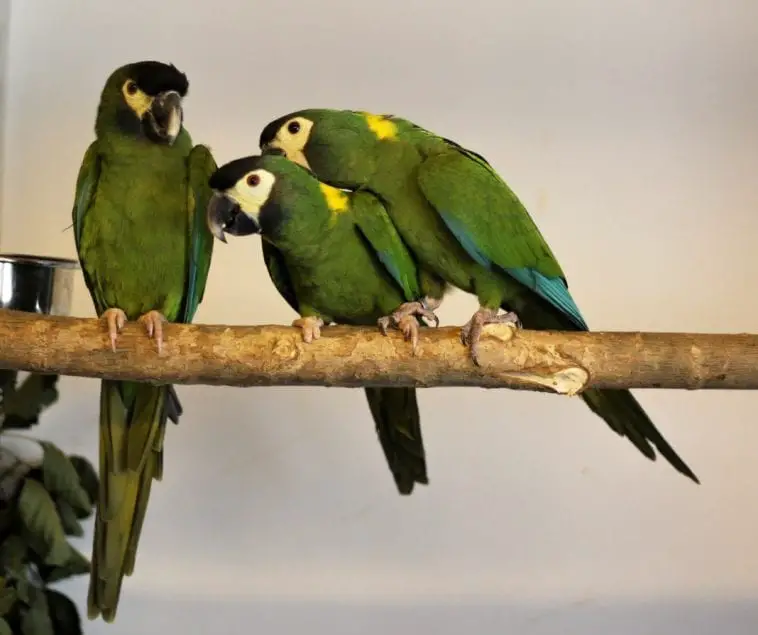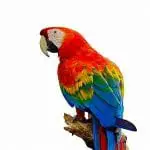Scientific Facts
| Common Name: | Yellow-collared Macaw, yellow-naped macaw, Cassin’s macaw, Golden-collared macaw |
| Scientific Name: | Ara auricollis |
| Life Span: | Up to 50 years |
| Weight: | Between 8 to 10 ounces |
| Length: | About 15 to 17 inches |
| Habitat: | Forests and woodlands |
| Country of Origin: | South America |
Physical Description
Primarily, the yellow-collared macaws have bodies that are covered with green feathers. Compared to other parrots, their green color can be a little darker, but some individuals are also seen in lime green and olive green shades. Their namesake is taken from the yellow bands seen at the back of their necks or their napes. Also, the tails of these yellow-collared macaws are maroon with bright blue spots at the tips. When they are in flight, these birds also have a yellow tint on the underside of their wings.
Additionally, the foreheads of these birds are colored with a mixture of blue and black, which is a huge contrast in comparison to their white eye patches surrounded by an orange iris. Their beaks, on the other hand, are a solid black, then fading into a white point at the end of the upper mandible, and their feet are flesh-colored.
The males and females of the species look alike because this is a monomorphic species of bird. If an owner seeks to identify the genders, only DNA testing or a surgical procedure is the only way to tell these birds apart. Also, owners should not be swayed by a lackluster color while these birds are still young because their colors will become brighter as they age.
Conservation Status
The yellow-collared macaws still have a fair amount of population, and they are classified as Least Concern by the organizations BirdLife International and IUCN. But, these mini-macaws are also listed in CITES Appendix II, which means there are regulations monitoring the import and export of these birds.
Availability and Natural Habitat

The Yellow-collared Macaws are native inhabitants of central South America. Their range includes some parts of Bolivia, as well as parts of Argentina and northern Paraguay. Some Yellow-collared Macaws can also be found in southwest Brazil, along with a small area in the center part of that country.
In the wild, Yellow-collared Macaws can create tight relationships with their mates, and they are rarely seen apart, even when they were still living in flocks. These birds nest in tree cavities within tropical forests and low woodlands. As with other parrot species, these birds are threatened and are verging on endangered.
Behavior
Embed Code: <iframe width=”480″ height=”360″ src=”https://www.youtube.com/embed/H1fGja6PXBk” frameborder=”0″ allow=”accelerometer; autoplay; encrypted-media; gyroscope; picture-in-picture” allowfullscreen></iframe>
Yellow-collared Macaws love attention, and they enjoy being a part of the family. They are charming, crafty, and comical, just like how larger macaw species behave. The difference is that they are smaller, easier to care for, and are much more affordable. It is also easy to train these birds because of their inherent intelligence, and they also learn to talk using a considerable number of words.
These birds are affectionate, but they are somewhat mischievous. The Yellow-collared Macaws, in fact, have a reputation for being an intelligent and resourceful species. They thrive from receiving attention from their owners, and they also seek their need for attention by all means necessary. As an owner, you should, therefore, expect a greeting when you get home, plus lots of love and affection, whether you want it or not.
Additionally, most Yellow-collared Macaws make excellent pets for families. It would be better if a bird starts socializing while they are generally friendly by nature. These qualities are extensions from their pairing and flocking instincts, which they will apply to the humans that they live with.
Exercise and Training
Embed Code: <iframe width=”480″ height=”360″ src=”https://www.youtube.com/embed/wrAtBZg1acY” frameborder=”0″ allow=”accelerometer; autoplay; encrypted-media; gyroscope; picture-in-picture” allowfullscreen></iframe>
The yellow-collared macaws should be given ample time to play, and they usually prefer to do this using large and spacious cages. Though the cages might seem to be too big for their size, these sizes are just enough for hyperactive yellow-collared macaws. As owners, you also have the responsibility to maintain their mental and physical health levels.
Additionally, you should make sure that the yellow-collared macaw gets a minimum of one to two hours of playtime outside its cage each day. The pet bird can use this time to stretch their legs and exercise their beaks and wings. Keepers should also make the most of this opportunity and use it to work on training the birds, may it be for fun bird tricks or for learning words and phrases. These yellow-collared macaws enjoy clowning around, and owners will also enjoy the time and rewards that bring out this part of their personality.
When these yellow-collared macaws are outside the cage, a sturdy play stand with a place for toys and treats is also an important thing for these playful little acrobats. Your entire home also serves as these birds’ home away from their home, so it is essential that you give them time to explore and be part of the household action.
The yellow-collared macaws also tend to do much better with positive reinforcement, so you should remember to ignore their bad behavior and reward the things they do good. When you see your yellow-collared macaw being a little unruly, sometimes what it would take to correct the behavior is to place these birds back on their perch. With a little patience, your yellow-collared macaw will learn to make you happy.
Responsible yellow-collared macaw owners should also be generous in providing toys, whether inside or outside the birdcages. The yellow-collared macaw needs to stay busy and active, so the more bird-friendly toys you can provide, the happier these birds will be. Most preferred materials range from leather, rope, and wood. You should also install a water dish that can be purposed as a birdbath. When given a chance, the yellow-collared macaws enjoy splashing around with water and swim around.
Food and Eating Habits

Embed: <iframe width=”640″ height=”360″ src=”https://www.youtube.com/embed/704kp6TN0FU” frameborder=”0″ allow=”accelerometer; autoplay; encrypted-media; gyroscope; picture-in-picture” allowfullscreen></iframe>
Although the range of yellow-collared macaws can be relatively small, these birds can still be naturally found in several countries. This provides these birds with a great variety of local nuts, seeds, fruits, and vegetables that you should eat. A yellow-collared macaw that is considered as a pet should also be fed with a diet that is just as varied.
You should also offer your yellow-collared macaw with a high-quality extruded pellet, as well as fresh fruits and vegetables every day. You should also do some supplementation using nuts and seeds so that you can keep your pet happy and healthy. Finally, you should provide them with fresh drinking water at all times.
Breeding
When the yellow-collared macaws are within their home range, they usually breed from October to April. These birds usually make their nests in the cavities of trees. A clutch of these birds consists of 2 to 4 eggs, which are incubated for about a month. Additionally, both the male and female parents feed and protect their young until they are ready to fend for themselves. These chicks begin fledging when they reach 3 months old, but they will remain with their parents for some time after fledging.
Common Health Problems
Like other macaws and parrots in the new world, the yellow-collared macaw is hardy, robust, and they can adapt quickly to their environments. In fact, this is reflected in the long lifespan of these birds. But, as an owner, if you are interested in keeping these birds at their best conditions, you need to be aware of the essential issues that most birds in captivity encounter. These things include a lot of interaction, regular hygiene, and a healthy diet. If you make the mistake of neglecting your pet macaw and taking things for granted, you can cause physical and emotional distress for your loving pet and friend.
Communication
Embed: <iframe width=”480″ height=”360″ src=”https://www.youtube.com/embed/dUXeE6da9E4″ frameborder=”0″ allow=”accelerometer; autoplay; encrypted-media; gyroscope; picture-in-picture” allowfullscreen></iframe>
The yellow-collared macaws are vocal and loud by nature. Because of their sharp intelligence, these birds are quite good at memorizing simple everyday words and phrases. The yellow-collared macaws enjoy goofing off and showing off the words they learn and the tricks that they master. However, if the yellow-collared macaws are feeling neglected, alarmed, or bored, these birds will let you know with a noisy and harsh call. These noises can be a definite issue for anyone who lives in a condominium or an apartment complex.
Environment and Housing

For their housing needs, the yellow-collared macaws must be provided with an aviary or a suspended cage with a minimum length of 3 to 4 meters. A roomy cage is required so that the bird has ample time to relax, but if you can, make sure to still let them out for a few hours each day. They should also have parrot perches and a playpen.
Fun Facts about the Yellow-collared Macaw
- The yellow-collared macaws were first described by John Cassin, an American ornithologist in 1853.
- Some bird enthusiasts refer to the yellow-collared macaws as Cassin’s macaws, to give credit to the discoverer.
- The name of the yellow-collared macaws called “auricollis,” which came from “aurum,” meaning gold and “collum,” meaning neck.
- The yellow-collared macaws often have a length of about 38 centimeters or 15 inches, where most of it comes from the tail feathers.
- The yellow-collared macaws are listed in CITES Appendix II. This means that commercial trading of these birds is allowed as long as an export permit is completed.
Where Can You Get a Pet Yellow-collared Macaw?
If you are interested in getting a Yellow-collared Macaw, do not overlook this species in favor of a more colorful bird or a larger macaw. The Yellow-collared Macaws are readily available for purchase in the pet trade, and it can be easy to find in avian stores and bird breeders. You can also opt to adopt some individuals by connecting with bird rescue organizations.
How to Care for a Pet Yellow-collared Macaw?
Embed: <iframe width=”640″ height=”360″ src=”https://www.youtube.com/embed/DE847FXP_1k” frameborder=”0″ allow=”accelerometer; autoplay; encrypted-media; gyroscope; picture-in-picture” allowfullscreen></iframe>
In caring for Yellow-collared Macaws, owners must be prepared for these birds to become extremely attached and dependent on their human families. These birds crave a lot of attention and interaction, and because of this, these birds are not a good choice if you do not have several hours a day to devote to bonding with their pets.
While these Yellow-collared Macaws are generally not as noisy as larger birds in their family, these birds are more than capable of being quite loud when the mood strikes. Some people also compare the call of these birds to be similar to a gull. Basically, this means that they may not be the best option as a pet if you live in a condominium or an apartment.
Additionally, these Yellow-collared Macaws are gifted in learning to talk just like humans. They are capable of learning to speak in a string of words and phrases. In fact, there are owners that note that these Yellow-collared Macaws can speak much better compared to other bird species.
These Yellow-collared Macaws are also skilled as escape artists, which is a result of their curious and sometimes mischievous personality. Yellow-collared Macaws should make sure that a cage is safe and secure.
Overall, the Yellow-collared Macaws are engaging and lively birds that are excellent companions for their owners. If they are provided the right amount of training, affection, and discipline, these birds are actually affectionate and loyal pets.
Frequently Asked Questions
How much does a Yellow-collared Macaw cost?
Yellow-collared Macaws are available for 700 dollars to 1,100 dollars, more or less.
Do Yellow-collared Macaws make good pets?
The Yellow-collared Macaws are more easily trained compared to larger species, and they are often made as pets because of their friendly and loving nature.
How long do Yellow-collared Macaws live?
Yellow-collared Macaws live for about 50 years on average, when they receive the best amount of care and protection from their owners.
Are Yellow-collared Macaws endangered?
Yellow-collared Macaws have high numbers of existence, and they are considered to be species of least concern by the IUCN Red List and Birdlife International.
What do Yellow-collared Macaws eat?
Yellow-collared Macaws love to feed on seeds, flower buds, and fresh fruits.



